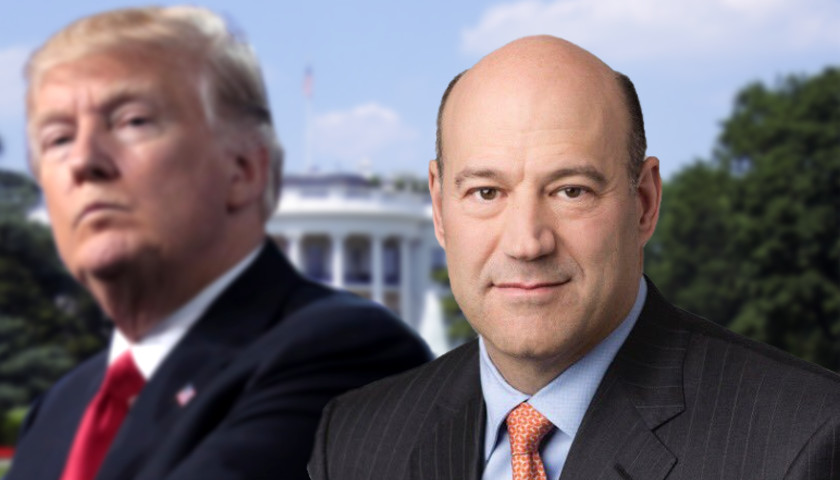by George Rasley, ConservativeHQ.com Editor
Every time we begin to think that President Trump’s economic advisor Gary Cohn and the other Democrats the President brought into in the West Wing have lost influence, one of them surfaces to remind us of what a huge mistake it was for Trump to let them inside the White House fence, let alone give them big offices in the White House.
Cohn’s latest contribution to killing the Trump presidency is the idea of raising the gas tax – with this tone-deaf idea being floated in the middle of the President’s push to cut income taxes on America’s middle-income families and job-creating businesses.
What Cohn, and those who inhabit his portal to portal limo riding world, don’t seem to get is how gasoline and transportation costs affect the quality of life for middle and lower income families.
As a 2016 Pew study showed, the share of household income used for transportation has increased substantially over the past two decades, the amount going to various subcategories, like gasoline, also grew. For all income groups, expenditures for gasoline and motor oil doubled between 1996 and 2014. For households in the lower third, the average annual cost of fuel, auto insurance, vehicle maintenance and repair, and public transportation in 1996 averaged $2,000 a year; by 2014, this group spent nearly $2,100 just on fuel. These extreme cost increases force households to make difficult choices and trade-offs to meet other core needs, such as food and housing.
Households in the lower income group spend significantly less in absolute dollars, but much more as a share of their income, on transportation than did those in the middle- or upper-income groups. Further, transportation costs increased in recent years for households at the bottom, while this spending was more stable for the other income groups. Lower-income households spent nearly 16 percent of their income on transportation in 2014, up from 9 percent four years earlier. In contrast, households in the middle spent about 11 percent of their income on transportation in 2014, while those at the top spent 8 percent the Pew study found.
Overall, Pew found that median household expenditures grew by about 25 percent between 1996 and 2014, returning to pre-recession levels. After declining during and after the Great Recession, expenditures increased between 2013 and 2014 in particular. In 2014, the typical American household spent $36,800.
Although expenditures recovered from the downturn, income did not.
As the recovery began, Pew found that median household expenditures returned to pre-crisis levels, but median household income continued to contract. By 2014, median income had fallen by 13 percent from 2004 levels, while expenditures had increased by nearly 14 percent.
Low-income families spent a far greater share of their income on core needs, such as housing, transportation, and food, than did upper-income families. Households in the lower third spent 40 percent of their income on housing, while renters in that third spent nearly half of their income on housing, as of 2014.
Because their core spending absorbed so much of their income, households in the lower income tier spent considerably less than their middle- and upper-income counterparts on discretionary items, such as food away from home and entertainment.
Although all households had less slack in their budgets in 2014 than in 2004, lower-income households went into the red. In 2004, typical households at the bottom had $1,500 of income left over after expenses.
By 2014, this figure had decreased by $3,800, putting them $2,300 in the red. The lack of financial flexibility threatens low-income households’ financial security in the short term and their economic mobility in the long term concluded the Pew study.
To put it in the simplest terms possible, there has been a dramatic reduction in the quality of life for America’s middle and lower income families over the past 13-years, and gasoline and transportation figure lprominently in that calculation.
As our friend John Carney of Breitbart observed recently:
The [gas tax] increase would raise the tax to around 10.3 percent at current gas prices, up from 7.47 percent today.
Advocating having the federal government take more money from Americans at the gas pump would run contrary Trump administration’s goal of cutting taxes for the middle class. Most studies of the tax have shown that an increase in the gas tax would fall most heavily on the American middle class and the poor, since these households spend far more of their income on gas than the wealthy. When judged by household expenditures, the gas tax would hit middle income Americans the hardest.
A gas tax would also hurt many American businesses because additional money spent to fuel cars leaves households with less money to spend on restaurants, clothing, and leisure. Because it raises the cost of transporting goods, the gas tax would also put upward pressure on the prices of consumer goods. It’s likely that the overall effect of a gas tax would be to lower economic growth, making it more difficult for the administration to achieve its goals of three to four percent growth in GDP.
Carney’s conclusions are supported by the findings of the Pew study cited above, but they miss the fundamental political dynamic involved.
It’s not just the impact on economic growth, it’s the impact on quality of life for middle and lower income families that Washington should be worrying about. Increasing the gas tax means not going to the movies, or not going out to dinner, or not buying that new back-to-school sweater or postponing car repairs or purchases for middle and lower income families – but not for Gary Cohn.
It’s time for Washington’s elite to recognize that voters who are rapidly being assigned to lives of Stalinist-like drudgery by the twin forces of globalist pressure on wages and rising taxes are unlikely to forever passively accept that fate.
Published with permission from ConservativeHQ.com.






Is he channeling Governor Haslam – the one who finagled to a get an unnecessary tax on gasoline passed?